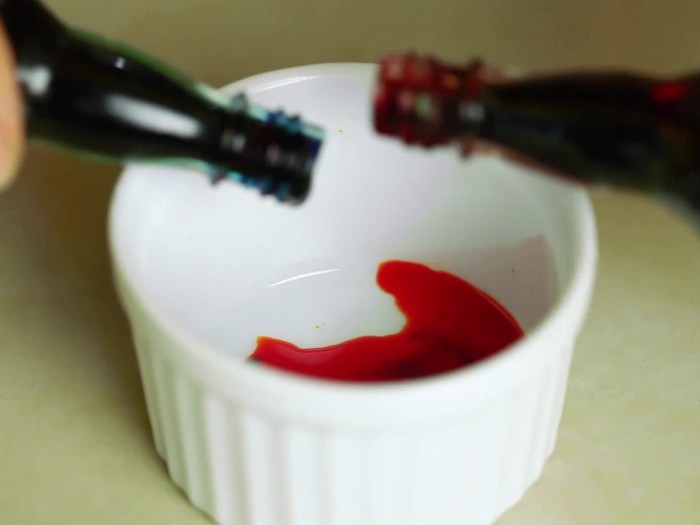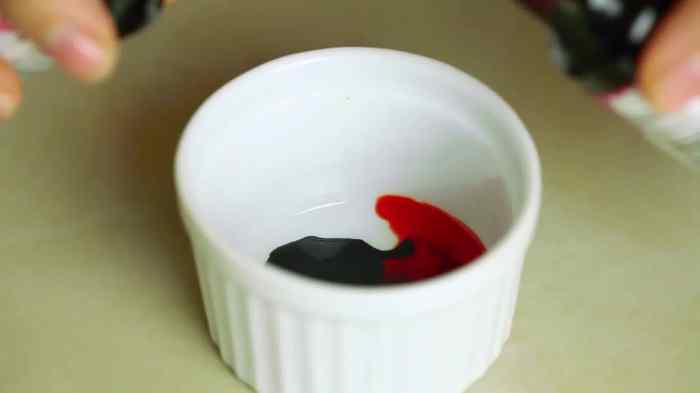Commercial Black Food Coloring

Make black food coloring – Commercial black food coloring, unlike its natural counterparts, is a complex blend of synthetic ingredients designed to achieve a deep, consistent black hue in food products. Understanding its composition, potential health effects, and manufacturing process is crucial for both consumers and food manufacturers.
Chemical Composition of Commercial Black Food Coloring
Commercial black food coloring typically consists of a mixture of several synthetic dyes, often including FD&C Blue No. 1, FD&C Blue No. 2, FD&C Yellow No. 5, and FD&C Red No. 40.
The specific combination and proportions of these dyes vary depending on the manufacturer and desired shade of black. These dyes are often combined with additives to enhance their stability and solubility in food products. These additives might include preservatives and stabilizers. Precise ratios are proprietary information and differ significantly between brands.
Potential Health Implications of Commercial Black Food Coloring
The safety of synthetic food colorings, including those used to create black food coloring, is a subject of ongoing research and debate. While the FDA generally considers these dyes safe at approved levels, some individuals may experience allergic reactions or sensitivities. These reactions can range from mild skin irritation to more severe symptoms. There is also ongoing research into the potential long-term health effects of consuming these dyes, although conclusive evidence of serious harm remains limited.
For example, some studies have explored potential links between certain food dyes and hyperactivity in children, though results have been inconsistent.
Comparison of Natural and Commercial Black Food Colorings
Natural black food colorings, such as activated charcoal or black cocoa powder, offer a different profile compared to their synthetic counterparts. Natural options generally possess a less intense and potentially less uniform color. They may also exhibit less stability, meaning the color might fade or change over time or with exposure to light or heat. Conversely, commercial black food colorings tend to offer greater color intensity and stability, allowing for consistent coloring in various food applications.
Natural black food colorings, however, often provide additional flavor notes or nutritional benefits absent in the synthetic alternatives.
Crafting a deep, vibrant black food coloring often involves meticulous blending of various natural or artificial pigments. However, the intensity of such colors can sometimes lead to unintended staining on skin, so knowing how to counteract this is crucial. Should you find yourself with a stubborn stain, consult this helpful guide on how to remove food coloring from skin for effective removal techniques.
Returning to our black food coloring, remember careful application is key to preventing such mishaps.
Manufacturing Process of Commercial Black Food Coloring
The manufacturing process for commercial black food coloring involves a complex series of chemical reactions and purification steps. The individual dyes are synthesized in separate processes, often involving complex organic chemistry. These dyes are then carefully blended in specific proportions to achieve the desired black shade. Quality control measures are implemented throughout the process to ensure consistent color, purity, and safety.
After blending, the final product is usually standardized and packaged for distribution to food manufacturers. This involves rigorous testing to meet FDA standards for purity and safety before release to the market.
Applications of Black Food Coloring in Food: Make Black Food Coloring

Black food coloring, while less common than other colors, offers a unique and dramatic visual impact to various food products. Its use can range from creating a sophisticated aesthetic to mimicking naturally occurring dark colors. Understanding its applications allows for creative culinary exploration and improved product presentation.
Many foods naturally contain dark pigments, but sometimes, achieving a consistently deep black hue requires the addition of food-grade coloring. This is especially important in mass-produced items where natural color variations could affect consumer perception.
Foods Commonly Using Black Food Coloring
Black food coloring isn’t used as widely as other colors, but it finds its niche in specific applications where a deep, dark color is desired. The following list shows examples of foods where black food coloring is frequently employed to achieve a specific visual effect.
- Black ice cream: Achieving a truly intense black color often requires food coloring.
- Black sesame desserts: Enhancing the natural dark color for a richer appearance.
- Black pasta: Creating a visually striking dish.
- Black buns/breads: Achieving a dramatic contrast in color and texture.
- Certain candies and chocolates: Adding a mysterious and elegant look.
- Black cocktails: Creating a visually impressive and sophisticated drink.
Examples of Black Food Coloring Enhancing Visual Appeal, Make black food coloring
The use of black food coloring isn’t just about adding darkness; it’s about controlling the intensity and uniformity of the color. Here are a few examples showcasing how this works.
- Black ice cream: A small amount of black food coloring can transform a vanilla base into a dramatic, deep black. Without it, the color might appear grayish or uneven.
- Black sesame cookies: Adding black food coloring intensifies the color of the sesame seeds, making the cookies appear richer and more appealing.
- Black velvet cake: The intense black color creates a striking contrast against the frosting, enhancing the overall visual impact.
Black Sesame and Coconut Macarons Recipe
This recipe demonstrates how black food coloring can transform a familiar dessert. The color enhances the visual appeal, making the macarons appear more elegant and sophisticated. The flavor remains largely unchanged, with the subtle black sesame adding a nutty complexity.
Ingredients:
- 1 cup powdered sugar
- 1 cup almond flour
- 1/4 cup black sesame seeds
- 2 large egg whites
- 1/2 cup granulated sugar
- 1 teaspoon black food coloring
- 1/2 cup desiccated coconut for coating
Instructions: (A full recipe would be significantly longer, this is a simplified version for illustrative purposes)
- Combine powdered sugar, almond flour, and sesame seeds.
- Whip egg whites until stiff peaks form.
- Gradually add granulated sugar and black food coloring to egg whites.
- Gently fold dry ingredients into egg white mixture.
- Pipe macarons onto baking sheet.
- Bake and let cool.
- Coat cooled macarons in desiccated coconut.
Impact: The black food coloring deepens the color of the macarons, creating a visually striking contrast with the light coconut coating. The flavor profile is enhanced by the nutty sesame seeds, while the black food coloring itself adds no significant flavor.
Table of Food Applications and Desired Effects
This table summarizes different applications of black food coloring and the visual effects it aims to achieve.
| Food Item | Desired Effect | Color Intensity | Additional Notes |
|---|---|---|---|
| Black Ice Cream | Deep, intense black color | High | Can be combined with other flavors |
| Black Pasta | Dramatic, visually striking appearance | Medium-High | Often uses squid ink as a natural component |
| Black Buns | Mysterious, sophisticated look | Medium | Charcoal powder can be used in addition to coloring |
| Black Velvet Cake | Elegant, high-contrast appearance | High | Color is enhanced by the light-colored frosting |
FAQ Insights
Can I use black food coloring in baking?
Yes, but be mindful of its impact on texture and taste. Start with small amounts and test your recipe.
Is black food coloring vegan?
It depends on the source. Natural options like charcoal are typically vegan, but check commercial products for animal-derived ingredients.
How long does homemade black food coloring last?
Store it properly in an airtight container in a cool, dark place. Natural colorings generally have a shorter shelf life than commercial options.
Are there any potential health risks associated with consuming black food coloring?
Some commercial colorings contain artificial ingredients; always check labels and opt for natural options when possible. Excessive consumption of any food coloring may have unintended consequences.
